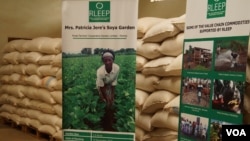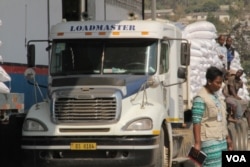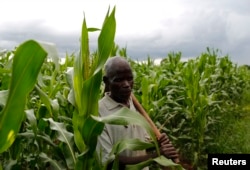Three years of El Nino-induced drought and flooding left half of Malawi's population dependent on food aid, but this year, the country is reporting a good maize harvest. Malawi’s government banned the export of maize and maize products in 2015 amid food shortages.
But now things are changing.
Latest crop production estimates by the Ministry of Agriculture show that maize production will rise to 3.2 million tons, up from last year’s 2.3 million tons.
The surplus has already sent local selling prices tumbling. The Farmers Union of Malawi said in a statement that “maize prices in the eastern region of Africa range from $300 to $700 per metric ton." Farmers say that is almost triple what local buyers offer.
“They should lift the export ban on maize," says Felix Jumbe, a commercial maize farmer in central Malawi. "That would unlock the prices that are too low at the moment. Because K50, K30 per kilogram is equally stealing from farmers by vendors.”
The government insists that the food security situation remains uncertain and it will not lift the export ban on maize.
Jumbe, who is also the chairperson for the Alliance for Commodity Trade in East and Southern Africa, says if anything, there is a need for a compromise via ADMARC, the national grain marketer, or NFRA, the National Food Reserve Agency.
“I would suggest that the government should buy all the maize through ADMARC or NFRA at an export parity price – the same price that they would export – then the farmers will have the money and the government will have the stock," Jumbe says.
The government says it does not have the funds to do that.
“I am sure you are aware that in 2002 we were in a similar situation," notes Joseph Mwanamveka, Minister of Industry, Trade and Tourism. "We had surplus maize and we never kept, and then we sold the maize to Kenya. And then we ended up in a shortfall and then we were looking around to buy back the maize that we sold.”
Mwanamveka says this time, the government will have to assess the situation before allowing exports.
“There are surveys that need to be done and establish how much we keep in strategic grain reserve and how much should we export. We have not reached that stage yet," he says. "So once it has been established that we have enough, not only for this year, because people are just looking for this year, we will be able to allow exports.”
Rafik Hajat, the executive director of the Blantyre-based research organization Institute for Policy Interaction, says the government is right to be cautious. Hajat recommends the ban remain in place until the National Food Reserve has stocked at least a two-year supply of maize.
“We have no guarantee that we will have rains next year. We haven’t implemented [an] irrigation scheme as planned. So I am reminded of the dream that the pharaoh had in Egypt of seven years of plenty and followed by seven years of starvation," Hajat says.
The Farmers Union of Malawi warns that the low price farmers are currently fetching for their maize could leave them at risk of hunger and deepening poverty as they will have to sell larger quantities of their harvests this year to make ends meet.
Meanwhile, the government has deployed the military in all border districts to enforce the export ban. Malawi’s president, Peter Mutharika, made the order two months ago after police in northern Malawi impounded over 30 trucks loaded with maize intended for illegal export to neighboring Tanzania.









